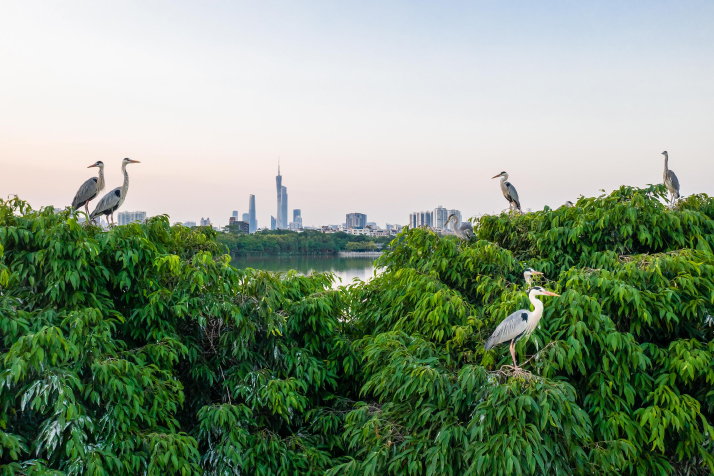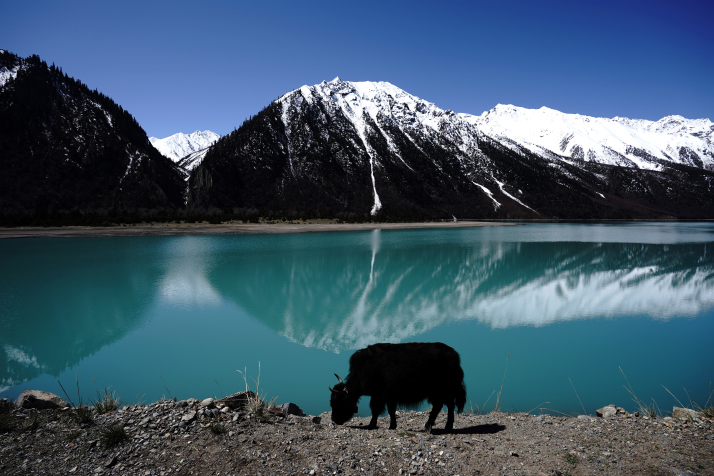| Editor's Choice |
| China's ecological protection picks up steam | |
| China has put more emphasis on protecting the environment which has been damaged by rapid economic development | |
|
|
 The Haizhu Wetland Park in Guangzhou, capital city of Guangdong Province in south China, on April 27 (XINHUA)
During an inspection tour of Ningxia Hui Autonomous Region in northwest China, President Xi Jinping visited Wuzhong, where the Yellow River flows through the city's center, on June 8. "[Xi's] visiting the same river four times in one year indicates the importance of the ecological protection of the Yellow River for our country," a commentary by Xinhua News Agency said. Since 2012, the Central Government has put more emphasis on protecting the environment, which has been damaged by rapid economic development. The revised Environmental Protection Law that took effect in early 2015 provides stricter rules for environmental protection supervision and harsher punishment for any deeds that harm the ecological environment. Huang Runqiu, Minister of Ecology and Environment, announced during the Third Session of the 13th National People's Congress (NPC) in May that seven of the nine binding targets set for evaluating environmental protection work in the 13th Five-Year Plan (2016-20) had been achieved by the end of 2019. Huang's words were backed up by a report issued by the Ministry of Ecology and Environment (MEE) on June 2, which showed that China saw a steadily improving environment in 2019.  Ranwu Lake in Tibet Autonomous Region in southwest China on April 27 (XINHUA)
A national strategy The Yellow River, the second longest river in the country, is the cradle of China's civilization. The 5,464-km-long waterway spans nine provinces and autonomous regions, supplies water to more than 60 cities, feeds about 12 percent of China's population and supports 14 percent of the national GDP. It is on the priority list of ecological protection. Since the 1990s, the river has faced ecological challenges such as flow cutoff, contamination and silt buildup that might lead to floods. Given the fragile environment along the river, the government put forward a series of new measures to strengthen ecological protection and boost high-quality development. After stressing the importance of the river's ecological protection last August in Lanzhou, capital city of Gansu Province in northwest China, Xi set ecological protection and high-quality development of the Yellow River Basin as a major national strategy at a symposium in Henan Province in central China on September 15, 2019. In May, amid the slowdown of the economy and uncertainties brought on by the novel coronavirus outbreak, Xi visited the Yellow River in Shanxi Province in north China. After the annual sessions of the 13th NPC and the 13th National Committee of the Chinese People's Political Consultative Conference (CPPCC) concluded in Beijing in late May, the president visited the Yellow River again in Ningxia. Intensive measures have been taken to enhance ecological protection and control along the river this year. In late May, drawing on the experience of mapping sewage outlets along the Bohai Sea and the Yangtze last year to control sewage discharge, the MEE launched a similar campaign to improve the environment along the banks of the Yellow River. On June 5, World Environment Day, the Supreme People's Court issued a guideline on improving legal services to protect the Yellow River Basin's environment and promote development, directing courts along the river to provide stronger legal protection to its environment and ecology and mete out harsher punishment to polluters. According to statistics from the top court, 246 judicial teams specializing in environmental cases have been established in the courts. In addition, the country has built more than 400 wetland nature reserves and national parks in the river basin. Ma Chaohong, a protector at a Yellow River wetland nature reserve in Luoyang, Henan, has been observing birds at the reserve through telescope for two decades. When the reserve was set up in 1995, there were only about 40 species in the reserve. Now, the number has increased to over 250, with more than 100,000 birds nesting in the reserve. "I was born on the bank of the river," Ma told Henan TV. "Since the 1990s, with more human activity and industrial projects along the river, the environment was greatly contaminated. But in recent years, with intensive protection measures, I would say the scene now more or less mirrors the image of my childhood memories." Thanks to efforts in conserving water sources and controlling soil erosion, the environment along the Yellow River in Gansu Province has been improved significantly, according to Ouyang Jian, a member of the 13th National Committee of the CPPCC and Chairman of the CPPCC Gansu Provincial Committee. At the same time, he admitted that the ecological environment in the Yellow River Basin is still fragile and suggested setting up an ecological compensation mechanism, along with a special national fund for ecological protection and high-quality development of the Yellow River. On May 9, the Ministry of Finance, together with three other ministries, issued a plan to pilot ecological compensation in nine provinces and regions in the river basin. Under an ecological compensation mechanism, beneficiaries and polluters in the river basin should provide compensation for victims and protectors.  A staff member patrols a marine ranch in the sea area of Wuzhizhou Island in Sanya, Hainan Province in south China, on March 28. It is China's first tropical marine ranch (XINHUA)
Visible improvements The latest figures from the MEE showed further improvement in China's environment. Carbon dioxide emissions per unit of GDP, an important environmental indicator, fell 4.1 percent in 2019 from the previous year. Some 74.9 percent of surface water monitored by the MEE was graded as of good quality in 2019, up 3.9 percentage points from 2018. From January 20 to June 6, the average concentration of PM2.5, a fine particulate matter harmful to human health, in 337 large cities was 34 micrograms per cubic meter during the same period, down 15 percent year on year. Chen Xushuang, a Beijing resident, said she is satisfied with the improvement in air quality in the capital. "Just a few years ago, a clear blue sky was a rare blessing, since the city was mostly choked in smog," she told Beijing Review. "But now we enjoy blue skies most of the time. This is the best spring sky I have ever experienced in Beijing during my 10 years living here." "The density of all air pollutants was at a comparatively low level compared with previous records for the same period in Beijing this spring," Liu Bingjiang, head of the MEE's Air Quality Management Department, said at a news conference on May 15. "The improvement in air quality is extraordinary." Production resumption in April didn't cause a jump in pollutant emissions either, Li said, attributing this to both the plunge in factory activity during the epidemic and the country's long-term efforts to enhance air quality management. This improvement has been seen in most areas of the country. "Since the 18th National Congress of the Communist Party of China in 2012, the Central Government has stepped up environmental protection," Zhao Yingmin, Vice Minister of Ecology and Environment, said at a press conference on June 10. Citing data from a communiqué from the first and second national surveys on sources of pollution conducted from 2007 to 2019, Zhao said the discharge of major pollutants recorded a drastic drop. Back in September 2013, the State Council, China's cabinet, issued the Air Pollution Prevention and Control Action Plan, setting goals for the reduction of emissions by 2017. In July 2018, the country rolled out a three-year campaign for blue skies. Emissions have been declining ever since. Along with air quality control, the government also issued plans on water and soil pollution in 2015 and 2016, respectively. A report released by the Chinese Academy of Agricultural Sciences (CAAS) on June 5 showed that China has made steady and comprehensive progress in promoting green agricultural development. Mei Xurong, Vice President of CAAS, said the use of pesticides and synthetic fertilizers has steadily declined and recycling of agricultural waste is improving at a consistent pace. "China has made achievements in the early stages of developing green agriculture," Mei said. "Now, it is important to set up a comprehensive evaluation mechanism and top-notch standards." Zhang Fusuo, a member of the Chinese Academy of Engineering and a professor at China Agricultural University, said cross-sector expertise and innovation are crucial in advancing the green development of agriculture. In late May, the MEE began to plan for the environmental protection of soil for the 14th Five-Year Plan (2021-25) period. Information from Xinhua showed that despite a tighter budget this year, funds earmarked by the Central Government to support ecological and environmental protection in 2020 saw a year-on-year increase. There are other improvements underway this year as well. Garbage sorting has been adopted in over 70 percent of housing estates in 18 cities to date, while China will halt all imports of solid waste by the end of the year. Despite all the achievements China has made, Huang said people should stay clear-headed about the still perilous situation and the arduous tasks the country faces in ecological and environmental protection. "The turning point for ecological and environmental improvement in the country has yet to come," he said. "China still depends greatly on heavy and chemical industries in its industrial structure and on coal for energy." However, Huang added, "In the 14th Five-Year Plan period, we will continue our efforts to improve ecological and environmental quality by reducing pollutant emissions, as well as promoting ecological protection and restoration." (Print Edition Title: Green Becomes Greener) Copyedited by Rebeca Toledo Comments to yuanyuan@bjreview.com |
|
||||||||||||||||||||||||||||||
|
